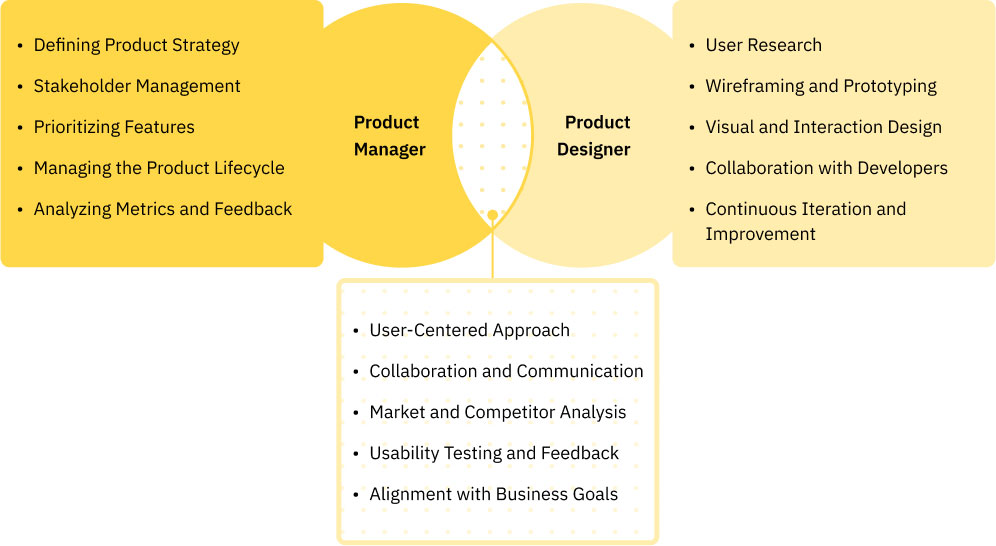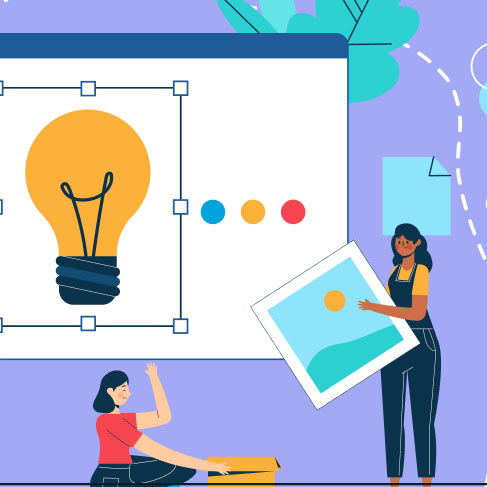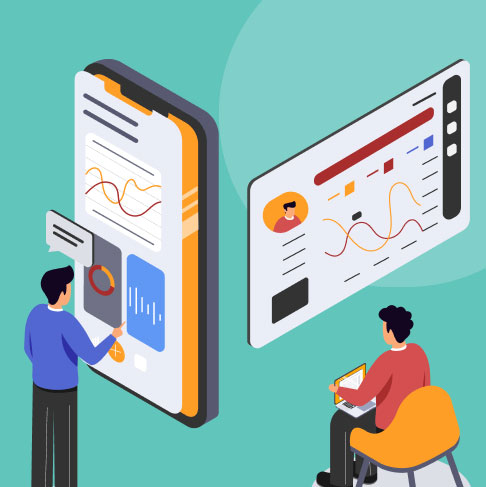Product Design vs. Product Management: Why They Need to Combine Forces
July 25, 2023 | Read Time : 3 mins
Table of Contents
In the world of software and product development, two critical roles often play a significant part in shaping the success of a product: product designers and product managers. While these roles have distinct responsibilities and skill sets, they share a common goal: creating exceptional user experiences and delivering valuable products.
However, to truly unlock the potential of a product, product designers and product managers need to combine forces and collaborate closely throughout the product development lifecycle. In this blog, we’ll explore the importance of integrating product design and management, highlighting how their synergy can drive innovation, improve user satisfaction, and ultimately lead to successful product outcomes.
Product Design & Product Management
A strong collaboration between product designers and product managers is essential because both roles play distinct but complementary parts in the product development process. While product design focuses on creating visually appealing and intuitive user experiences, product management takes a broader view by defining product strategy, coordinating cross-functional teams, and monitoring market trends.
By understanding each other’s responsibilities and perspectives, designers and managers can align their efforts, ensuring that the product meets both user needs and business objectives. This collaboration forms the foundation for a successful product and lays the groundwork for the subsequent sections exploring the value of their combined forces.
Product Design
- Focuses on the user experience (UX) and visual aesthetics.
- Involves creating wireframes, prototypes, and design assets.
- Collaborates with stakeholders to define design requirements and goals.
- Ensures the product is intuitive, visually appealing, and meets user needs.
Product Management
- Concerned with overall product strategy and vision.
- Identifies market opportunities and defines product roadmaps.
- Coordinates with cross-functional teams (engineering, design, marketing) to deliver the product.
- Monitors and analyzes user feedback, market trends, and metrics for product improvements.
The Value of Collaboration
- Shared Understanding: Product designers and managers bring different perspectives, but by collaborating closely, they can ensure a shared understanding of user needs, business objectives, and technical constraints. Designers provide insights into user behavior, while managers contribute market research and business goals. A holistic product vision can be formed through collaboration, aligning design and product decisions with the overall strategy.
- Iterative Design and Agile Development: Organizations can adopt an iterative design process that aligns with agile development methodologies by integrating design and product management. Product managers can gather user feedback and market insights, which designers can leverage to refine and iterate on their designs. This iterative approach enables rapid prototyping, testing, and iteration, resulting in more user-centered and market-ready products.
- Design Thinking: Product designers bring design thinking methodologies emphasizing empathy, user research, and prototyping. Combined with product management’s business acumen, this can lead to more innovative solutions that address user needs and market demands. Design thinking helps teams to avoid assumptions, validate ideas, and generate creative solutions, ultimately driving better product outcomes.
Creating Seamless User Experiences
Users have increasingly high expectations when it comes to the usability, functionality, and overall delight they experience when interacting with a product. To achieve this level of excellence, product designers and product managers must collaborate closely, combining their expertise to create cohesive and intuitive user experiences. By aligning their efforts, designers and managers can ensure that the product strategy is translated into visually appealing and interactive experiences, resulting in satisfied and loyal users.
1. User-Centered Design
- Product designers focus on creating intuitive and delightful user experiences, understanding user journeys, and addressing pain points.
- Product managers can contribute by providing insights into user preferences, behavior, and market trends, helping designers make informed design decisions.
- Collaboration ensures the product aligns with user expectations, enhancing user satisfaction and loyalty.
2. Coherent Product Strategy
- Product management defines the product strategy, considering market opportunities, business goals, and competitive landscape.
- Collaborating with product designers can translate product strategy into cohesive and consistent visual and interactive experiences.
- Consistency across all product touchpoints builds trust, enhances brand identity, and creates a seamless user experience.
3. Visual Design and Branding
- Product designers are responsible for visual design, ensuring that the product’s aesthetics align with the brand’s identity and create a visually engaging experience.
- By collaborating with product managers, designers can gain insights into the brand strategy, target audience, and market positioning.
- Product managers can provide input on brand guidelines, messaging, and positioning, allowing designers to create visually cohesive and compelling experiences that resonate with the target users.
4. Usability Testing and Iteration
- Product designers conduct usability testing to evaluate their designs’ effectiveness and gather user feedback.
- Designers can obtain a broader perspective on user feedback, market demands, and business goals by involving product managers in the testing process.
- Product managers can analyze user feedback, identify patterns and trends, and collaborate with designers to iterate and refine the user experience, resulting in continuous improvements and increased user satisfaction.
4. Accessibility and Inclusivity
- Product designers strive to create inclusive and accessible user experiences that cater to diverse user needs and abilities.
- By collaborating with product managers, designers can ensure that accessibility requirements are considered in the product strategy and design process.
- Product managers can guide legal compliance, industry standards, and the importance of inclusivity, allowing designers to incorporate accessibility features seamlessly into the user experience.

Overcoming Challenges and Driving Success
- Communication and Alignment: Product designers and managers often face challenges due to miscommunication or misalignment of goals. Regular communication, collaboration tools, and joint meetings can foster better understanding, reduce friction, and align efforts toward common objectives. By establishing a shared language and working together, designers and managers can mitigate conflicts and ensure the product’s success.
- Balancing Constraints: Designers and managers must work together to balance user needs, technical feasibility, and business constraints. Product managers are crucial in advocating for the user experience while considering resource limitations, timelines, and market demands. Collaboration allows for trade-offs and prioritization, ensuring the product’s viability, desirability, and feasibility.
- Managing Scope Creep: Scope creep, the tendency for a project’s scope to expand beyond its original boundaries, can pose significant challenges to product development. Product designers and managers must collaborate to manage scope and prevent unnecessary feature bloat effectively. The team can make informed decisions about feature prioritization and avoid unnecessary distractions by having ongoing discussions and clearly defined product goals.
- Iterative Feedback Loops: Establishing iterative feedback loops between product designers and managers can significantly enhance the product’s success. Product managers can collect user feedback, market research, and analytics data to inform design decisions and iterate on the product. Designers can leverage this feedback to refine their designs and ensure they align with user expectations and business objectives.
- Empowering Cross-Functional Collaboration: Collaboration between product designers and managers should extend beyond their core roles and involve cross-functional teams. Engaging engineers, marketers, and other stakeholders early in the process fosters a sense of shared ownership and promotes collective problem-solving. By including diverse perspectives, the team can anticipate challenges, validate ideas, and ensure a comprehensive approach to product development.
- Adapting to Change: In the fast-paced world of product development, change is inevitable. Both product designers and managers must be adaptable and embrace flexibility. By working closely together, they can quickly respond to changes in user needs, market dynamics, or technological advancements. Collaboration allows agile decision-making and empowers the team to pivot, iterate, and continuously improve the product.






